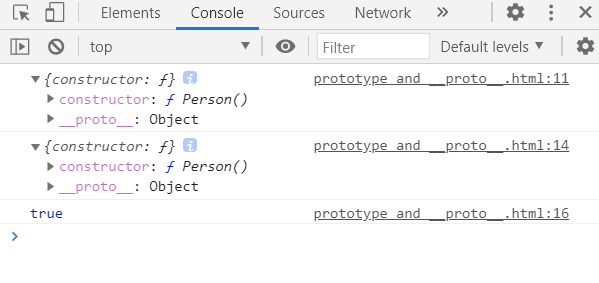内容参考:原型、原型链
1. 对应名称和从属关系
-
prototype: 即原型,是函数的一个属性,本身是一个对象{} -
__proto__: 即原型链(链接点),即对象 Object 的一个属性,本身也是一个对象{} -
对象的
__proto__保存着该对象的构造函数的prototype
example
<!DOCTYPE html>
<html lang="en">
<head>
<meta charset="UTF-8" />
<meta name="viewport" content="width=device-width, initial-scale=1.0" />
<title>Document</title>
</head>
<body>
<script>
function Person() {}
console.log(Person.prototype)
const person1 = new Person()
console.log(person1.__proto__)
// 实例对象的 __proto__ === 构造函数的 prototype
console.log(Person.prototype === person1.__proto__) // true
</script>
</body>
</html>
如上,我们声明一个构造函数 Person,打印出 Person 的 prototype 属性。接着,我们创建一个 Person 的实例对象 person1,打印出 person1 的 __proto__ 属性。最后,我们对两者进行 === 比较。
输出结果如下图所示:

因为构造函数的原型 Person.prototype 也是一个对象,对象都有 __proto__ 属性,则
// 所有函数的 prototype 都默认是 Object 的实例(Object除外)
console.log(Person.prototype.__proto__ === Object.prototype) // true
console.log(Object.prototype.__proto__) // null,原型链顶端为 null
2. 认识原型链、原型与原型链继承
给实例对象、构造函数的原型和 Object 的原型各添加属性 a、b 和 c。而通过 person1 我们可以访问到这些属性。
function Person() {}
const person1 = new Person()
person1.a = 1
Person.prototype.b = 2
Object.prototype.c = 3
console.log(person1.a); // 1
console.log(person1.b); // 2
console.log(person1.c); // 3
我们用下面这种形式来表示上边展示的代码,可以看出,如果我们在自身找不到需要的属性,那么它会自动在链上往上找。这就是原型链:
// person1 {
// a: 1,
// __proto__: Person.prototype = {
// b: 2,
// __proto__: Object.prototype = {
// c: 3,
// __proto__: null
// }
// }
// }
3. Function 和 Object 的特殊性
// const Person = new Function()
// 构造函数 Person 是由 Function 创建出来的
console.log(Person.__proto__ === Function.prototype) // true
console.log(Function.__proto__ === Function.prototype) // true(这是规定)
// const obj = new Object()
console.log(typeof Object) // function
console.log(Object.__proto__ === Function.prototype) // true
// 由前面代码推导可知:
console.log(Object.__proto__ === Function.__proto__) // true
4. 判断属性是否存在的方法
属性只在自身存在:
console.log(person1.hasOwnProperty('a')) // true
console.log(person1.hasOwnProperty('b')) // false
console.log(person1.hasOwnProperty('c')) // false
属性在链上存在:
console.log('a' in person1) // true
console.log('b' in person1) // true
console.log('c' in person1) // true